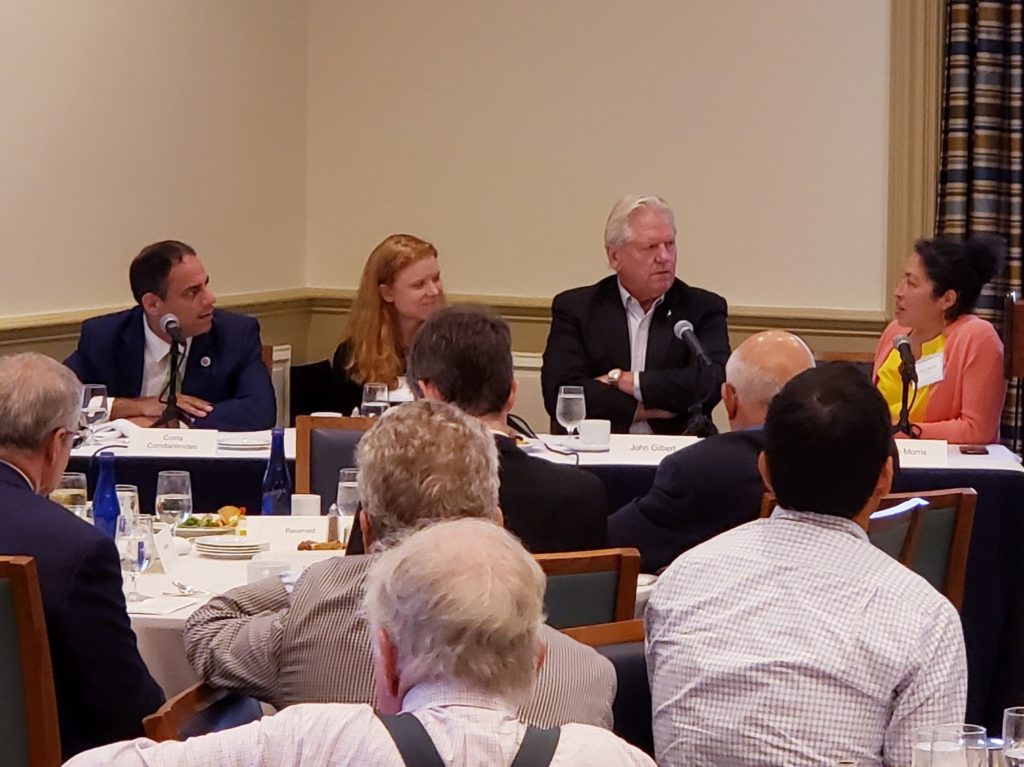|
Costa Constantinides is the New York City Council Member who introduced a recently passed retrofit bill that requires that buildings meet aggressive emission targets or face fines. John Gilbert is a well-known New York City real estate industry leader, and his company stands to face those fines. Robyn Beavers is an energy technology company CEO and former Google strategist who located her company in New York City to seize the opportunity to evolve the energy role of commercial buildings.
On July 18, 2019, OurEnergyPolicy.org brought together Constantinides, Gilbert, and Beavers to discuss the New York City’s new retrofit law and how to best address energy usage by property owners.
Retrofit Law Critiques
 “As well-intentioned as this bill is, we need to fix it,” said John Gilbert, Executive Vice President, CTO, and COO of Rudin Management Company. The new law mandates that all buildings 25,000 square feet or larger must reduce their current greenhouse gas emissions by 40% by 2030 and by 80% by 2050. However, Gilbert noted that he and all New York City property owners cannot control their tenants’ energy use, neither can they pass on the fines to them. In New York City—“the city that never sleeps”—many skyscraper tenants are businesses that use energy around the clock, which means they use much more energy than a business operating from normal 8:00 a.m.-5:00 p.m. office hours. “As well-intentioned as this bill is, we need to fix it,” said John Gilbert, Executive Vice President, CTO, and COO of Rudin Management Company. The new law mandates that all buildings 25,000 square feet or larger must reduce their current greenhouse gas emissions by 40% by 2030 and by 80% by 2050. However, Gilbert noted that he and all New York City property owners cannot control their tenants’ energy use, neither can they pass on the fines to them. In New York City—“the city that never sleeps”—many skyscraper tenants are businesses that use energy around the clock, which means they use much more energy than a business operating from normal 8:00 a.m.-5:00 p.m. office hours.
Complying with the law, compels Rudin and other property owners to look beyond energy efficiency measures and purchase renewable energy resources. He said his company has already done a great deal to implement energy efficiency measures; following an earlier benchmarking plan under Mayor Bloomberg, Rudin decreased its electric consumption by 41%, its carbon emissions by 44%, and its steam production by 48%. To comply with the new law, Rudin has tried to buy solar-, wind-, and hydropower-generated electricity, but Gilbert says there is no way for companies to do so right now in New York City. He said that Rudin faces millions of dollars in fines if his buildings do not comply with the new law, and many other property owners will potentially face similar penalties.
“New York is the city that never sleeps, but now it’s going to be that New York is the city that never sleeps, and if you don’t sleep, you get fined,” he said. “At the end of the day, if you’re giving the property owner the responsibility to control something they have no control over, the law will fail.”
Gilbert also expressed his concern that the law’s Advisory Board had insufficient representation by property owners.
Retrofit Law Details
New York City Council Member Costa Constantinides introduced the retrofit bill (Local Law 97), which the New York City Council passed in April 2019. It was part of a package of bills called the Climate Mobilization Act and was revised and finalized through a 2-year stakeholder engagement process. The greenhouse gas emission reduction requirements of 40% by 2030 and by 80% by 2050 apply to buildings that are 25,000 square feet or larger (with some exceptions). There are 50,000 of these buildings in New York City, and they are responsible for about 30% of New York City’s total emissions—a “big number for a small subset of buildings,” Constantinides said. Buildings will be fined if they fail to reach their targets. The law imposes emissions reductions in two tiers, with the worst emitters needing to reduce their emissions first.
 Constantinides said, although he realizes that the final legislation may not make everyone happy, it is both aggressive and achievable. The city formed a new Office of Building Energy Emissions Performance to not only enforce the law, but to provide technical assistance to building owners to help them make the necessary retrofits to reach their emission reductions. The legislation includes carbon trading as a potential compliance pathway and provides opportunities for building owners to take out low-interest or no-interest loans to help them affordably pay for energy efficient upgrades to their buildings. He said the Advisory Board includes only one property owner because they considered it important to assure representation for building owners but also include a cross-section of stakeholders. Constantinides said, although he realizes that the final legislation may not make everyone happy, it is both aggressive and achievable. The city formed a new Office of Building Energy Emissions Performance to not only enforce the law, but to provide technical assistance to building owners to help them make the necessary retrofits to reach their emission reductions. The legislation includes carbon trading as a potential compliance pathway and provides opportunities for building owners to take out low-interest or no-interest loans to help them affordably pay for energy efficient upgrades to their buildings. He said the Advisory Board includes only one property owner because they considered it important to assure representation for building owners but also include a cross-section of stakeholders.
He said the law is aggressive in terms of climate targets, while also making exclusions for buildings such as hospitals that needed to stay in business. The law also allows for building owners to apply for an adjustment either to their requirement or to their penalty if there is really no way they can get to their number. He said the fines are in line with what it would actually cost to upgrade a building. The law has a penalty only so that it is enforced.
“I don’t want anyone’s money. I want your carbon,” he said. “There are a lot of things that are in my control and a lot of things that are out of my control. But the things that I could control, I felt like we landed in a place that was aggressive, but that was fair and achievable.”
Additionally, he said that a large part of what he does as Chairperson of the Environmental Protection Committee is to “cut the red tape” and work on speeding up approvals, improving city government coordination, and making it easier for companies to access new technologies. He said the New York City Council has considered other pieces of legislation on submetering to try to bring accountability to tenants, as well as the property owners.
Commercial Building Opportunities
In the situations where Gilbert says companies like his are not able to meet the law’s requirements, Robyn Beavers, CEO of Blueprint Power, sees an opportunity for attracting new talent and creating a high-value new industry. Her New York City-based company is focused on out-of-the-box solutions such as transforming buildings into energy providers instead of just energy consumers, and connecting them to new energy markets and customers.
“There are a lot of efforts at the federal level, the state, and the city level to incent new types of supply. And that’s a huge opportunity for buildings, she said. “Buildings can become flexible resources…and they can deliver high-quality services to the grid.”
 She said that advances in data put buildings in a position where property owners can exchange their energy with other buildings rather than just trying to limit their energy use. However, there must be successful coordination with state and local entities to make this successful. Beavers noted that the ability to achieve a lot of these goals is hindered not only by red tape locally, but by insufficient coordination on the city, state, and federal policy levels. She said that state authorities define sub-metering rules, so a change to allow fines to be passed onto the consumer of the electricity—as Gilbert suggested—would require a change in state policy. She said that advances in data put buildings in a position where property owners can exchange their energy with other buildings rather than just trying to limit their energy use. However, there must be successful coordination with state and local entities to make this successful. Beavers noted that the ability to achieve a lot of these goals is hindered not only by red tape locally, but by insufficient coordination on the city, state, and federal policy levels. She said that state authorities define sub-metering rules, so a change to allow fines to be passed onto the consumer of the electricity—as Gilbert suggested—would require a change in state policy.
Constantinides said companies like Blueprint Power have an important role for successful implementation of the retrofit bill because the emissions mandates are meant to spur ingenuity and innovation in renewable energy markets and energy efficiency in order for building owners to meet their requirements.
|

 “As well-intentioned as this bill is, we need to fix it,” said John Gilbert, Executive Vice President, CTO, and COO of Rudin Management Company. The new law mandates that all buildings 25,000 square feet or larger must reduce their current greenhouse gas emissions by 40% by 2030 and by 80% by 2050. However, Gilbert noted that he and all New York City property owners cannot control their tenants’ energy use, neither can they pass on the fines to them. In New York City—“the city that never sleeps”—many skyscraper tenants are businesses that use energy around the clock, which means they use much more energy than a business operating from normal 8:00 a.m.-5:00 p.m. office hours.
“As well-intentioned as this bill is, we need to fix it,” said John Gilbert, Executive Vice President, CTO, and COO of Rudin Management Company. The new law mandates that all buildings 25,000 square feet or larger must reduce their current greenhouse gas emissions by 40% by 2030 and by 80% by 2050. However, Gilbert noted that he and all New York City property owners cannot control their tenants’ energy use, neither can they pass on the fines to them. In New York City—“the city that never sleeps”—many skyscraper tenants are businesses that use energy around the clock, which means they use much more energy than a business operating from normal 8:00 a.m.-5:00 p.m. office hours. Constantinides said, although he realizes that the final legislation may not make everyone happy, it is both aggressive and achievable. The city formed a new Office of Building Energy Emissions Performance to not only enforce the law, but to provide technical assistance to building owners to help them make the necessary retrofits to reach their emission reductions. The legislation includes carbon trading as a potential compliance pathway and provides opportunities for building owners to take out low-interest or no-interest loans to help them affordably pay for energy efficient upgrades to their buildings. He said the Advisory Board includes only one property owner because they considered it important to assure representation for building owners but also include a cross-section of stakeholders.
Constantinides said, although he realizes that the final legislation may not make everyone happy, it is both aggressive and achievable. The city formed a new Office of Building Energy Emissions Performance to not only enforce the law, but to provide technical assistance to building owners to help them make the necessary retrofits to reach their emission reductions. The legislation includes carbon trading as a potential compliance pathway and provides opportunities for building owners to take out low-interest or no-interest loans to help them affordably pay for energy efficient upgrades to their buildings. He said the Advisory Board includes only one property owner because they considered it important to assure representation for building owners but also include a cross-section of stakeholders. She said that advances in data put buildings in a position where property owners can exchange their energy with other buildings rather than just trying to limit their energy use. However, there must be successful coordination with state and local entities to make this successful. Beavers noted that the ability to achieve a lot of these goals is hindered not only by red tape locally, but by insufficient coordination on the city, state, and federal policy levels. She said that state authorities define sub-metering rules, so a change to allow fines to be passed onto the consumer of the electricity—as Gilbert suggested—would require a change in state policy.
She said that advances in data put buildings in a position where property owners can exchange their energy with other buildings rather than just trying to limit their energy use. However, there must be successful coordination with state and local entities to make this successful. Beavers noted that the ability to achieve a lot of these goals is hindered not only by red tape locally, but by insufficient coordination on the city, state, and federal policy levels. She said that state authorities define sub-metering rules, so a change to allow fines to be passed onto the consumer of the electricity—as Gilbert suggested—would require a change in state policy.